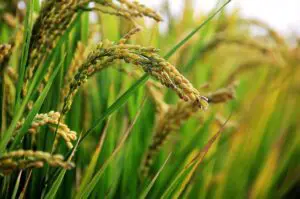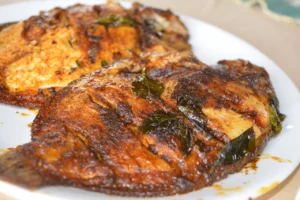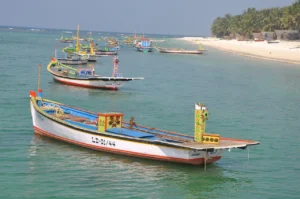Nestled in the azure waters of the Arabian Sea, the Lakshadweep archipelago beckons travelers with its pristine beaches, vibrant coral reefs, and a cultural tapestry as rich as its natural beauty. Yet, beyond the breathtaking landscapes, Lakshadweep is a haven for culinary enthusiasts seeking a taste of the unique flavors born from its geographical diversity, cultural amalgamation, and abundant marine resources. Join us on a culinary odyssey as we explore the gastronomic delights that make Lakshadweep’s cuisine a true paradise for the senses.
The Bounty of the Sea: A Culinary Symphony:

Lakshadweep’s geographical location, surrounded by the vast expanse of the Arabian Sea, has bestowed upon it an unparalleled treasure trove of seafood. The islanders have masterfully incorporated this bounty into their daily cuisine, with fish, especially tuna, emerging as a culinary cornerstone. Whether grilled to perfection, delicately fried, or expertly curried, the various preparations showcase the versatility of seafood, creating a symphony of flavors that reflects the islanders’ intimate connection with the sea.
In the pursuit of an authentic Lakshadweep culinary experience, one cannot overlook the significance of tuna. As a staple in the local diet, tuna takes center stage in dishes like the renowned “Kattu Chaar,” a flavorful fish curry that encapsulates the essence of Lakshadweep’s culinary heritage. The unique blend of spices, coconut milk, and the freshest catch from the surrounding waters creates a dish that not only satisfies the taste buds but also tells the story of a community deeply intertwined with its marine surroundings.
Coconut: The Soulful Essence of Lakshadweep Cuisine:

Venturing further into Lakshadweep’s culinary landscape, we encounter the omnipresent coconut—an ingredient that serves as the soulful essence of the island’s cuisine. Coconut, in its various forms—milk, grated, and oil—plays a pivotal role, infusing dishes with a rich and distinct tropical flavor. The use of coconut milk adds a velvety texture to curries, grated coconut serves as a garnish, and coconut oil, extracted from the island’s abundant coconut palms, is the preferred cooking medium.
As we savor the flavors of Lakshadweep, it becomes apparent that coconut isn’t just an ingredient; it’s a cultural emblem. From the soft hum of coconut palms in the breeze to the rich aroma of coconut-infused curries, each dish is a testament to the islanders’ resourcefulness and the profound connection they share with the land they call home.
Rice: The Canvas for Culinary Creativity:
Rice, as the staple grain, provides the canvas upon which Lakshadweep’s culinary creativity unfolds. Often served alongside seafood and coconut-based dishes, rice serves as a neutral counterpart, allowing the vibrant flavors of the region to take center stage. Biryani and pulao, two rice-based preparations, exemplify the marriage of aromatic spices, seafood, and the humble grain, resulting in dishes that are a celebration of both taste and tradition.

As we delve into the nuances of Lakshadweep’s cuisine, it becomes evident that rice isn’t merely a side dish but a crucial element in a culinary tapestry that reflects the island’s cultural diversity and historical influences.
Local Fruits: Nature’s Sweet Symphony:
Lakshadweep’s tropical climate gifts the islands with an abundance of flavorful fruits, including banana, papaya, mango, and pineapple. These locally grown treasures add a natural sweetness and refreshing quality to the island’s cuisine. Whether enjoyed fresh or incorporated into desserts, these fruits contribute to the symphony of flavors that define Lakshadweep’s culinary identity.

Picture indulging in a dessert made with the juiciest mangoes or savoring a tropical fruit salad that captures the essence of Lakshadweep’s sun-soaked landscapes. Each bite becomes a journey through the vibrant colors and flavors that make the island’s culinary offerings truly unique.
Lakshadweep Breads: Breaking Bread in Paradise:
No culinary exploration is complete without a nod to Lakshadweep’s bread offerings. Unleavened flatbreads like chapati and paratha take center stage, providing a versatile and comforting accompaniment to various dishes. These bread varieties are not just a means of satiating hunger but an integral part of the communal dining experience, bringing people together over a shared love for wholesome and delicious food.
As you break bread in Lakshadweep, you partake in a tradition that transcends the ordinary—every morsel a testament to the islanders’ ingenuity and their ability to transform simple ingredients into culinary delights.
Spices: A Delicate Dance of Flavors:
The spice profile of Lakshadweep’s cuisine is a delicate dance of flavors, where each spice plays a role in enhancing the natural taste of the ingredients. Local spices like cardamom, cinnamon, and cloves are used with a subtle hand, creating a symphony of aromas that waft through the air as dishes are prepared. Green chilies, providing a gentle heat, add a layer of complexity to the flavor profile, ensuring that each bite is a harmonious blend of tastes and textures.
Navigating the spice markets of Lakshadweep, one discovers not just ingredients but stories—stories of generations passing down the knowledge of spice blending, of the islanders’ appreciation for the finer nuances of flavor, and of a culinary tradition that has stood the test of time.
Traditional Dishes: A Culinary Heritage Unveiled:
In the heart of Lakshadweep’s culinary landscape lie traditional dishes that encapsulate the island’s rich heritage. “Kattu Chaar,” a fish curry brimming with local spices and the freshest catch, is a testament to the islanders’ prowess in transforming the bounty of the sea into a gastronomic masterpiece. Meanwhile, “Tuna Biryani,” featuring the abundant tuna fish available in the region, elevates rice to new heights, creating a dish that not only satiates hunger but transports diners on a culinary journey through the flavors of Lakshadweep.
These dishes are not just recipes; they are living artifacts, preserving the essence of Lakshadweep’s culinary heritage for generations to come. As you savor these traditional delights, you partake in a communion with the past—a journey through time, flavors, and the vibrant spirit of the islands.
Recipes:
Kattu Chaar (Fish Curry):

Ingredients:
- 500g fresh fish (preferably tuna), cleaned and cut into pieces
- 1 cup thick coconut milk
- 2 medium-sized onions, finely sliced
- 2 tomatoes, chopped
- 3 green chilies, slit
- 1-inch ginger, grated
- 4 cloves of garlic, minced
- 1 teaspoon turmeric powder
- 1 tablespoon red chili powder
- 1 teaspoon coriander powder
- 1 teaspoon cumin powder
- 2 sprigs curry leaves
- Salt to taste
- Coconut oil for cooking
Instructions:
- Heat coconut oil in a pan and sauté the sliced onions until golden brown.
- Add ginger and garlic, sauté for a minute until the raw smell disappears.
- Add turmeric powder, red chili powder, coriander powder, and cumin powder. Mix well.
- Add chopped tomatoes and cook until they become soft and the oil starts to separate.
- Add fish pieces, green chilies, and curry leaves. Cook for a few minutes, allowing the fish to absorb the flavors.
- Pour in thick coconut milk, season with salt, and simmer until the fish is cooked through and the curry thickens.
- Garnish with fresh curry leaves and serve hot with steamed rice.
Tuna Biryani:
Ingredients:
- 2 cups basmati rice, soaked for 30 minutes
- 500g tuna fish, cut into chunks
- 1 cup thick yogurt
- 2 large onions, thinly sliced
- 2 tomatoes, chopped
- 1/4 cup cooking oil or ghee
- 1 tablespoon ginger-garlic paste
- 1 teaspoon turmeric powder
- 1 teaspoon red chili powder
- 1 teaspoon biryani masala
- Whole spices (cinnamon, cardamom, cloves)
- Fresh coriander and mint leaves for garnish
- Salt to taste
Instructions:
- Cook the soaked basmati rice until it’s 70% done. Drain and set aside.
- In a pan, heat oil or ghee and sauté the sliced onions until golden brown. Remove half for later garnishing.
- Add ginger-garlic paste and sauté until the raw smell disappears.
- Add tomatoes, turmeric powder, red chili powder, biryani masala, and yogurt. Cook until the oil separates.
- Add tuna fish chunks and cook for a few minutes until the fish is partially cooked.
- In a large pot, layer half of the partially cooked rice, followed by the tuna mixture, and then the remaining rice.
- Sprinkle the reserved fried onions, fresh coriander, and mint leaves on top.
- Cover tightly and cook on low heat for about 20-25 minutes or until the rice is fully cooked and aromatic.
- Gently fluff the biryani with a fork, ensuring not to break the rice grains.
- Serve hot with raita or a side salad.
These traditional dishes capture the essence of Lakshadweep’s cuisine, showcasing the abundance of seafood and the vibrant flavors influenced by the region’s unique culture.
Sweets and Desserts: Jaggery and Coconut Delights:
Lakshadweep’s sweet offerings are a celebration of the natural sweetness of jaggery and the richness of coconut. “Lakshadweep Halwa,” a popular sweet dish made with coconut and sugar, exemplifies the islanders’ ability to turn simple ingredients into indulgent delights. As you indulge in these sweet treats, you experience not just the flavors but the essence of Lakshadweep’s sweet symphony—a melody of coconut, jaggery, and the warmth of island hospitality.
Each dessert tells a story—of celebrations, of shared moments, and of the islanders’ skill in turning everyday ingredients into extraordinary confections. It’s not just about satisfying a sweet tooth; it’s about experiencing the sweetness of life in Lakshadweep.

Recipe:
Lakshadweep Halwa – A Symphony of Coconut and Jaggery Delights
Ingredients:
- 1 cup grated fresh coconut
- 1 cup jaggery, grated or chopped
- 1 cup semolina (sooji)
- 1/2 cup ghee (clarified butter)
- 1/2 cup mixed nuts (cashews, almonds, pistachios), chopped
- 1/2 teaspoon cardamom powder
- A pinch of salt
- 2 cups water
Instructions:
- Grate the fresh coconut, ensuring it is finely grated for the best texture and flavor.
- Grate or chop the jaggery into small pieces to facilitate easy melting during cooking.
- Chop the mixed nuts and set aside, reserving a small portion for garnishing.
- In a heavy-bottomed pan, heat the ghee over medium heat.
- Add semolina to the pan and roast it on low to medium heat until it turns golden brown. Stir continuously to avoid burning.
- Once the semolina is roasted, add the freshly grated coconut to the pan and mix well.
- Introduce the grated or chopped jaggery into the mixture, stirring continuously to ensure even distribution and to prevent lumps.
- Gradually add water to the mixture, stirring consistently to achieve a smooth consistency.
- Continue cooking on low heat, allowing the halwa mixture to thicken and start detaching from the sides of the pan.
- Add a pinch of salt to balance the sweetness and incorporate the delightful aroma of cardamom powder. Stir well to infuse the flavors into the halwa.
- In a separate small pan, heat a tablespoon of ghee and roast the chopped mixed nuts until they turn golden brown and emit a fragrant aroma.
- Add the roasted nuts to the halwa mixture, reserving a small portion for the final garnish.
- Continue cooking until the halwa reaches the desired consistency, thick and gooey. Ensure it doesn’t stick to the bottom of the pan.
- Once the halwa achieves the desired texture, remove it from the heat.
- Garnish the halwa with the reserved roasted nuts, providing a delightful crunch and enhancing the visual appeal.
- Allow the Lakshadweep Halwa to cool for a few minutes before serving.
- Scoop generous servings onto plates or bowls and relish the symphony of coconut, jaggery, and nuts.
Lakshadweep Halwa is best enjoyed when warm, offering a decadent and comforting experience. The amalgamation of coconut and jaggery creates a unique sweetness that encapsulates the essence of Lakshadweep’s sweet culinary heritage. Serve it during festive occasions, celebrations, or simply as a luxurious treat to transport your taste buds to the paradisiacal flavors of the islands.
Beverages: Toasting to Island Life:
As our culinary journey through Lakshadweep unfolds, beverages emerge as an integral facet of the overall experience. Coconut water, renowned for its refreshing and hydrating qualities, transcends its status as a mere drink; it becomes a sip of the island’s very essence. Traditional beverages like “Kurumba,” meticulously extracted from coconut palms, extend an invitation to immerse oneself in the rich cultural tapestry of the islands, beckoning you to participate in local festivities and social gatherings.
Raising a glass in Lakshadweep is more than a simple toast; it is a celebration of the spirit that defines these islands—their time-honored traditions, the diverse spectrum of flavors that permeate every sip, and the genuine warmth that characterizes their hospitality. So, as you indulge in these island libations, you are not just enjoying a beverage; you are engaging in a heartfelt celebration of Lakshadweep’s vibrant life and culture.
Conclusion: A Culinary Tapestry Woven in Paradise:

In concluding our culinary odyssey through Lakshadweep, we find ourselves immersed in a tapestry of flavors, textures, and traditions that make this island paradise truly unique. From the bounty of the sea to the richness of coconut, the versatility of rice, and the vibrant notes of local fruits and spices, every element of Lakshadweep’s cuisine tells a story.
As you explore the culinary wonders of Lakshadweep, you embark on a journey that transcends the palate. It’s not just about the dishes; it’s about the people who craft them, the landscapes that inspire them, and the traditions that infuse them with a timeless charm. Lakshadweep’s cuisine is more than a collection of recipes; it’s a living, breathing testament to the islanders’ resilience, creativity, and deep connection with their natural surroundings.
So, as you savor the unique flavors of Lakshadweep, you’re not just indulging in a meal; you’re partaking in a culinary voyage—a journey through paradise on a plate.
#Lakshadweep #CuisineDelight

